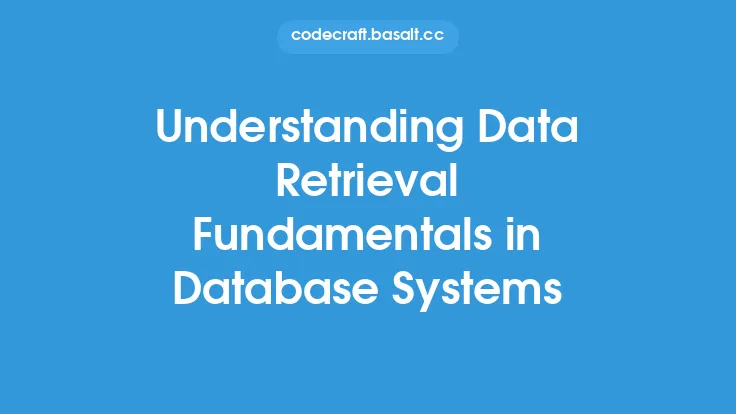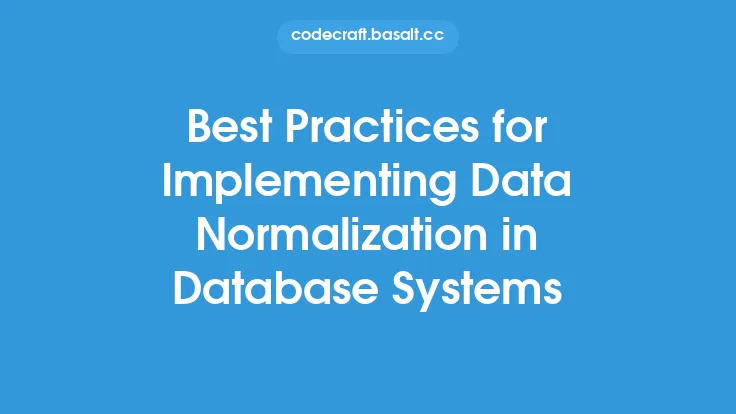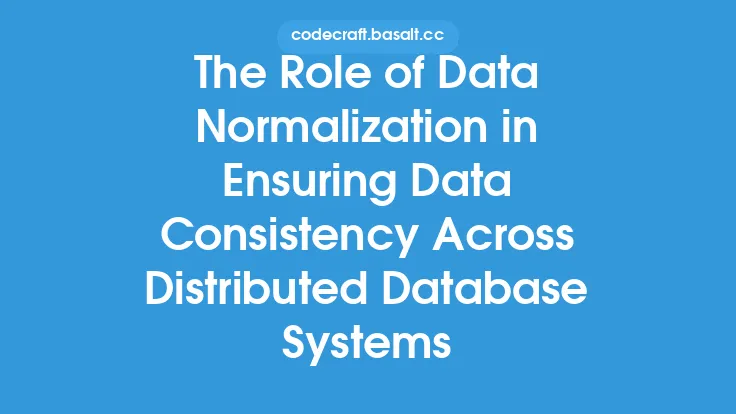Data normalization is a crucial concept in database systems that ensures data consistency, reduces data redundancy, and improves data integrity. It is a process of organizing data in a database to minimize data redundancy and dependency, making it easier to maintain and scale. Normalization involves dividing large tables into smaller, more manageable tables, and linking them through relationships. This process helps to eliminate data anomalies, such as insertion, update, and deletion anomalies, which can occur when data is not properly normalized.
Introduction to Data Normalization
Data normalization is based on a set of rules, known as normal forms, which are used to normalize data. The most common normal forms are First Normal Form (1NF), Second Normal Form (2NF), and Third Normal Form (3NF). Each normal form has its own set of rules and constraints that must be followed to ensure data consistency and reduce data redundancy. The normalization process involves analyzing the data and identifying the relationships between different tables and columns. This helps to identify data redundancy and dependency, which can then be eliminated through the normalization process.
Benefits of Data Normalization
Data normalization offers several benefits, including improved data consistency, reduced data redundancy, and improved data integrity. By minimizing data redundancy, normalization helps to reduce storage requirements and improve data retrieval performance. Normalization also helps to eliminate data anomalies, which can occur when data is not properly normalized. Additionally, normalization makes it easier to maintain and scale the database, as changes to the data can be made in one place, rather than multiple places.
Data Normalization Techniques
There are several data normalization techniques that can be used to normalize data, including entity-relationship modeling, data warehousing, and star and snowflake schema. Entity-relationship modeling is a technique used to identify the relationships between different entities in the database, while data warehousing is a technique used to store data in a centralized repository. Star and snowflake schema are techniques used to organize data in a data warehouse, with the star schema being the most common.
Normal Forms
Normal forms are a set of rules used to normalize data. The most common normal forms are First Normal Form (1NF), Second Normal Form (2NF), and Third Normal Form (3NF). First Normal Form (1NF) states that each table cell must contain a single value, while Second Normal Form (2NF) states that each non-key attribute in a table must depend on the entire primary key. Third Normal Form (3NF) states that if a table is in 2NF, and a non-key attribute depends on another non-key attribute, then it should be moved to a separate table.
Data Normalization and Database Design
Data normalization is an important aspect of database design, as it helps to ensure data consistency and reduce data redundancy. A well-designed database should be normalized to minimize data anomalies and improve data integrity. The database design should also take into account the relationships between different tables and columns, as well as the data types and constraints used to define the data. By following the principles of data normalization, database designers can create databases that are scalable, maintainable, and efficient.
Data Normalization Tools and Technologies
There are several data normalization tools and technologies available, including database management systems, data modeling tools, and data warehousing tools. Database management systems, such as MySQL and Oracle, provide built-in support for data normalization, while data modeling tools, such as Entity-Relationship Diagrams (ERDs), help to identify the relationships between different entities in the database. Data warehousing tools, such as Amazon Redshift and Google BigQuery, provide support for data normalization and data warehousing.
Challenges and Limitations of Data Normalization
While data normalization offers several benefits, it also has some challenges and limitations. One of the main challenges of data normalization is the complexity of the normalization process, which can be time-consuming and require significant expertise. Additionally, data normalization can lead to increased complexity in the database design, which can make it more difficult to maintain and scale. Furthermore, data normalization may not always be necessary, especially in cases where data redundancy is not a significant issue.
Conclusion
In conclusion, data normalization is a fundamental concept in database systems that ensures data consistency, reduces data redundancy, and improves data integrity. By following the principles of data normalization, database designers can create databases that are scalable, maintainable, and efficient. While data normalization has some challenges and limitations, its benefits make it an essential aspect of database design. As database systems continue to evolve, the importance of data normalization will only continue to grow, making it a crucial concept for database professionals to understand and master.





